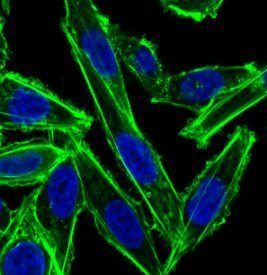Content #1
Content #1
Content #1
Stimulation of plasma membrane receptors initiates second messenger signaling pathways inside the target cells. In a recent study, Escue and colleagues from the University of Tennessee Health Science Center showed that diffusion of second messengers through gap junctions could propagate responses to cells distant from the site of stimulation. They focally instilled thrombin along with a fluorescent tracer into mouse lung microvessels. After perfusion with fixation and permeabilization reagents, the lung was stained with CF™488A phalloidin to visualize actin filaments in microvessels. They showed that thrombin induced stress fiber formation in microvessels >1000 um away from the site of direct thrombin exposure. Stress fiber formation in distant cells was mediated by IP3 and required Connexin 43 gap junction protein. Their study highlights the intercellular dynamics that can be observed in tissues in situ but not in cell culture.
To read the original article, click here.
Escue, R. Kandasamy, K. and Parthasarathi, K. Thrombin Induces Inositol Trisphosphate-Mediated Spatially Extensive Responses in Lung Microvessels. Am J. Pathol 2017 doi: 10.1016/j.ajpath.2016.12.014

Biotium has an extensive list of CF™ dye bioconjugates, including the actin filament stain Phalloidin. For more information on our CF™ dyes, click here.